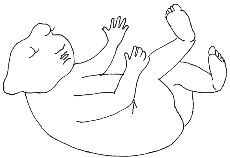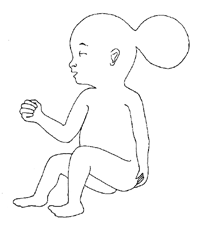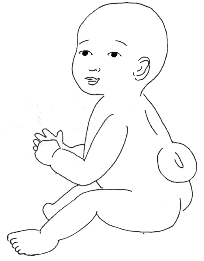|
Lesson 1: Vocabulary
Before the lesson, use the slide
show for this information to show to students after the vocabulary
section. A two-headed zipper (that starts in the middle and
closes at both ends) could be used to demonstrate the closing of the neural tube.
Or edges of a piece of paper could be joined lengthwise to form a large tube.
Several paper clips could be used to secure the edges together, from the middle toward
both ends. This could show the closing of the neural tube. If the bottom of
the "tube" doesn't close completely it can cause spina bifida. If the top
of the "tube" doesn't close it could cause anencephaly. Look at day 22 of
the slide
show for more information about
this.
Group
Activity
Concept mapping
teaches by adding to what students already know and creating mental connections
with new material. Give students 2 minutes to write down everything they know
about these familiar words: Pregnancy, Baby,
Birth Defects, Family, Genes and Environment. Have the students write their
ideas on strips cut out from 8-1/2-by-11 inch paper. Next have the students tape the
strips to a piece of butcher paper so it can be displayed for the class.
There are two sets of concepts to master. The basic concepts relate specifically to the
birth defects described in this module. The epidemiologic concepts relate to scientific
research methods and epidemiology.
To teach the vocabulary of the basic concepts, you can create a new birth defects
concept map using the terms below. An
example map using the vocabulary is given here. Print the birth defects vocabulary page to create a
transparency. Have students read the words and definitions, then add these terms,
definitions, and connecting arrows to their own mind maps. They will be able to keep
these mind maps to remind them of vocabulary definitions and to add more information
later. Likewise, you can create an epidemiology concept map. An example epidemiology concept map is given here. To
create a transparency of the epidemiology vocabulary words, click here.
Vocabulary
Estimated time: 20 minutes
birth de·fect
A birth defect is a problem that happens while a baby is developing inside the
mother. Not all of the baby's parts may form right and work right. Three
out of every 100 babies are born with a birth defect. Babies with birth defects may
need surgery or other medical treatments. However, they often lead full lives if they
receive the medical and other types of help they need. Most birth defects happen
during the first 3 months of pregnancy.
em·bry·o
An unborn baby from the beginning of pregnancy through the first 8 weeks.
spin·al cord
A long tube of nerve tissue inside the bony spinal column, running from the brain down the
length of the back. It controls movement and feeling.
neu·ral tube
The tube along the back of an embryo which later becomes the spinal cord and brain.
neu·ral tube de·fect (NTD)
Problems in the growth of the spinal cord and brain in an embryo, when the neural tube
doesn't close at the top (anencephaly) or the bottom (spina bifida). The defects
occur in the first month of pregnancy, before most women know they are pregnant.
About 7 babies are born in the U.S. each day with these birth defects.
TRY
THIS!!
Link to slide show
an·en·ceph·a·ly
A fatal birth defect that happens when the neural tube does not fully close
at the top. As a result, the skull and brain do not form properly. Babies with
anencephaly die before or shortly after birth.
Link to larger definition and picture
to create overhead slide.

en·ceph·a·lo·cele
A birth defect that is often fatal.
Part of a baby's
skull does not form properly, and part of the brain is outside of the skull. Those babies
who do survive often have severe physical and mental handicaps. Link to larger definition and picture to create overhead
slide.
Link to larger definition and
picture to create overhead slide.
spi·na bi·fi·da 
A birth defect of the back bone and spinal cord that leaves the spinal
cord exposed. A person with spina bifida may have learning
disabilities or problems
going to the bathroom because of lack of bowel and bladder control, and usually needs crutches
or a wheelchair to get around. Eighty to 90% of babies with spina bifida
survive, and most lead productive lives.
Link to larger definition and
picture to create overhead slide.
Link to Lesson 2: Case
Description
Date: September 1, 2006
Content source: National Center on Birth Defects and Developmental
Disabilities
|